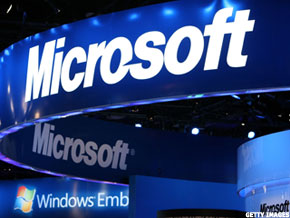Late Monday afternoon, a Bloomberg article appeared quoting an unnamed source suggesting that Microsoft(MSFT) would look to tap the debt markets and use the money to fund a higher dividend and do more stock buybacks. The stock ended up more than 5% in the last hour of trading. For Microsoft, that's a monster move.
The company has come under increased shareholder pressure to disgorge its ample cash to shareholders. Last month, I filed a shareholder resolution to be voted on this November at the shareholders' meeting calling on Microsoft to dramatically increase its payout ratio on its regular dividend, as well as considering stock buybacks.
Last week, Microsoft CFO Peter Klein spoke at theCiti(C) Tech conference and got an earful frominvestors in the Q&A about the dividend and cap structure. Klein and Microsoft Investor Relations GM Bill Koefoed also spoke last week to many Microsoft holders, including me, about their views on these questions.
Although I can't disclose what they said during our meeting, here is a summary of my argument to them:
Microsoft is greatly under-appreciated by investors today at current levels. Yet, the company can take its greatest weakness (the perception that it has all this excess cash because it is not growing as quickly as its younger, nimbler rivals) and turn it into its greatest strength (by using its cash to payout a dividend that gets yield-hungry investors to sit up and realize that holding Microsoft is safer than U.S. Treasuries).There is constant reference in the media these days for "the hunt for yield" by investors, but Microsoft is never mentioned even though it is best positioned to take advantage of this secular trend.Every pension fund in America today has promised its pensioners it will deliver 8% annual returns forever. They are having trouble in the last three years meeting that commitment. They -- and other large and small investors -- would beat a path to Microsoft's door if there was a substantial increase in the regular dividend.The status quo for Microsoft of stock buybacks and marginal annual increases to the regular dividend (which returned $16 billion in cash to shareholders last year) isn't working given thestock price. Microsoft needs to be bold.There are 3 levers that Microsoft can and should pull to get investors' attention in the coming weeks:1. Most important, in my view, is to substantially increase the regular dividend. I believe it should be nothing less than a doubling of the dividend. Investors would be happy to sit and wait for the market to better see the value in the stock if they were getting a whopping payout. A large increase in the payout would also assuage investor fears that Microsoft might do a large, ill-advised acquisition (like Yahoo!(YHOO) or Research in Motion(RIMM)) which would waste shareholders' money on declining assets.
Although some in the media have raised the question about how wise it is to increase the dividend with the uncertainty of the dividend tax rate, I asserted that I thought this issue was irrelevant. Even assuming the rate goes up, that argues even more for why a drastic increase in the payout is necessary just to tread water.
2. Tapping the debt markets. Johnson & Johnson(JNJ) recently raised $1.1 billion in the debt markets selling 10- and 30-year notes at record low rates. JNJ paid 2.95% on their 10-year notes. In May 2009, Microsoft made its first foray into the debt markets, selling $3.75 billion. Back then, Microsoft paid 4.2% on their 10-year notes.
Why not raise the cash at these levels, especially when Microsoft is seen as more creditworthy than the U.S. government and is one of only a handful of AAA corporate issuers. I reminded Klein that I'd written an article prior to their first debt offering where I pointed out that Microsoft could issue $60 billion in debt and only match IBM's (IBM) current debt-to-cash ratio.
........
[** This post is an excerpt of the full article, which is available on TheStreet.com by clicking here. Free Site.**]

 09/15/10 - 08:00 AM EDT
09/15/10 - 08:00 AM EDT
